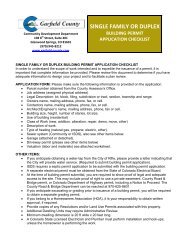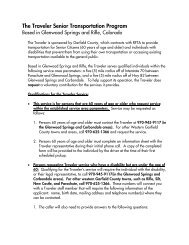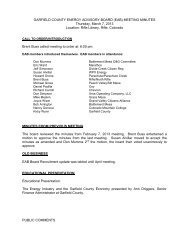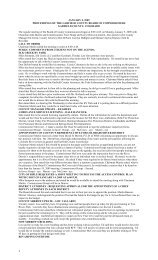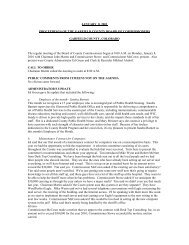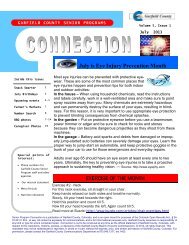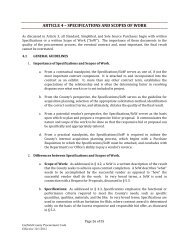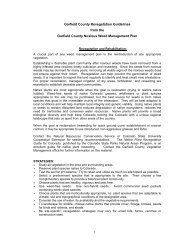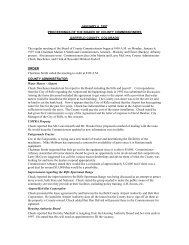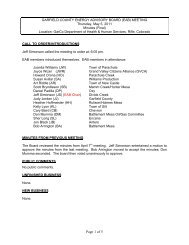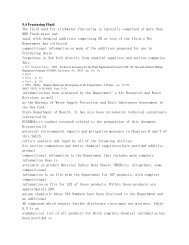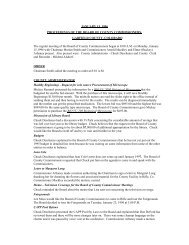Appendix D: Human Health Risk Assessment - Garfield County ...
Appendix D: Human Health Risk Assessment - Garfield County ...
Appendix D: Human Health Risk Assessment - Garfield County ...
Create successful ePaper yourself
Turn your PDF publications into a flip-book with our unique Google optimized e-Paper software.
<strong>Appendix</strong> D Screening Level <strong>Human</strong> <strong>Health</strong> <strong>Risk</strong> <strong>Assessment</strong> February 2011<br />
Battlement Mesa, Colorado <strong>Health</strong> Impact <strong>Assessment</strong> Colorado School of Public <strong>Health</strong><br />
and burning, coughing, breathing difficulties, and upset stomach. Long term exposures to<br />
high concentrations may case decreased lung function, dizziness, headache, liver<br />
problems, skin blotches, and anemia (ATSDR 2006).<br />
4.2.7 Ethylbenzene<br />
Sources of ethylbenzene in ambient air include petroleum hydrocarbons, fuel combustion,<br />
forest fires, solvents, pesticides, printing ink, varnishes, coatings, paints, and cigarette smoke<br />
(ATSDR 2010). Potential sources of ethylbenzene associated with natural gas<br />
development and production are the natural gas resource itself, emissions from trucks and<br />
diesel generators, and fracking fluids containing diesel and other petroleum products<br />
(Antero has stated that it does not use diesel in fracking fluids).<br />
EPA has determined ethylbenzene is not classifiable as human carcinogen (Class D). The<br />
International Agency for Research on Cancer (IARC) has classified ethylbenzene as<br />
possibly carcinogenic to humans, based on sufficient evidence in animal studies (IARC<br />
2000). An increased incidence of lung adenomas in males and of liver adenomas in<br />
females was observed in an inhalation study on mice (IRAC 2000).<br />
Non-cancer health effects from exposure to ethylbenzene in air include eye and<br />
respiratory irritation, hearing loss, kidney damage and neurological effects. Short term<br />
exposure to high levels of ethylbenzene in ambient air can cause eye and throat irritation,<br />
vertigo, and dizziness. Animal studies indicate long-term exposure to low levels of<br />
ethylbenzene in ambient air may result in irreversible damage to the inner ear and<br />
hearing, as well as kidney damage. Rats ingesting large amounts of ethylbenzene had<br />
severe damage to the inner ear. Dermal exposure has caused eye damage and skin<br />
irritation in rabbits (ATSDR 2010b).<br />
4.2.8 Formaldehyde<br />
Sources of formaldehyde in ambient air include fuel combustion, forest fires, many<br />
household products, and secondary formation from the oxidation of other organic<br />
compounds in the atmosphere (ATSDR 1999). A potential source of formaldehyde<br />
associated with natural gas development and production is emissions from trucks and<br />
diesel generators, as well as secondary formation from other organic compounds that are<br />
emitted as a result of natural gas development and production.<br />
EPA has determined formaldehyde is probable human carcinogen with limited evidence<br />
of carcinogenicity in humans and sufficient evidence in animals (Class B1). Exposure to<br />
formaldehyde in ambient air may result in an increased risk for nasal and throat cancers<br />
(ATSDR 1999a).<br />
Non-cancer health effects from exposure to formaldehyde in air include eye and<br />
respiratory tract irritation, changes in pulmonary function, and neurological effects.<br />
(ATSDR 2010c).<br />
<strong>Appendix</strong> D page 35



